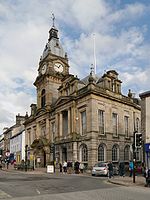Westmorland and Furness

Westmorland and Furness is a unitary authority area in Cumbria, England,. The economy is mainly focused on tourism around both the Lake District and Cumbria Coast, shipbuilding and the port in Barrow-in-Furness, and agriculture in the rural parts of the area. The council area formed on 1 April 2023, on the abolition of Cumbria County Council The council covers the areas formerly served by the districts of Barrow-in-Furness, Eden, and South Lakeland, which also ceased to function. It includes all of the area of the historic county of Westmorland as well as the Furness district of historic Lancashire. It also incorporates a very small part of historic Yorkshire, together with about a quarter of the area of (but only 10% of the population of) the historic county of Cumberland. The other part of Cumbria, to the north and west, forms the unitary authority area of Cumberland. The first elections to the new authority took place in May 2022, with the Westmorland and Furness Council acting as a 'shadow authority' until the abolition of the three former districts and Cumbria County Council on 1 April 2023.
Excerpt from the Wikipedia article Westmorland and Furness (License: CC BY-SA 3.0, Authors, Images).Westmorland and Furness
Kent Place,
Geographical coordinates (GPS) Address Nearby Places Show on map
Geographical coordinates (GPS)
| Latitude | Longitude |
|---|---|
| N 54.326 ° | E -2.745 ° |
Address
Kent Place
Kent Place
LA9 4DZ , Kirkbarrow
England, United Kingdom
Open on Google Maps










